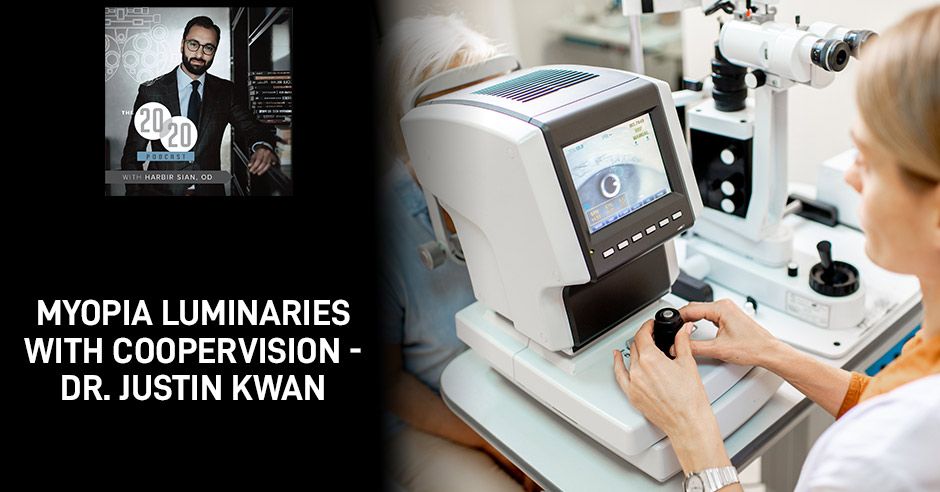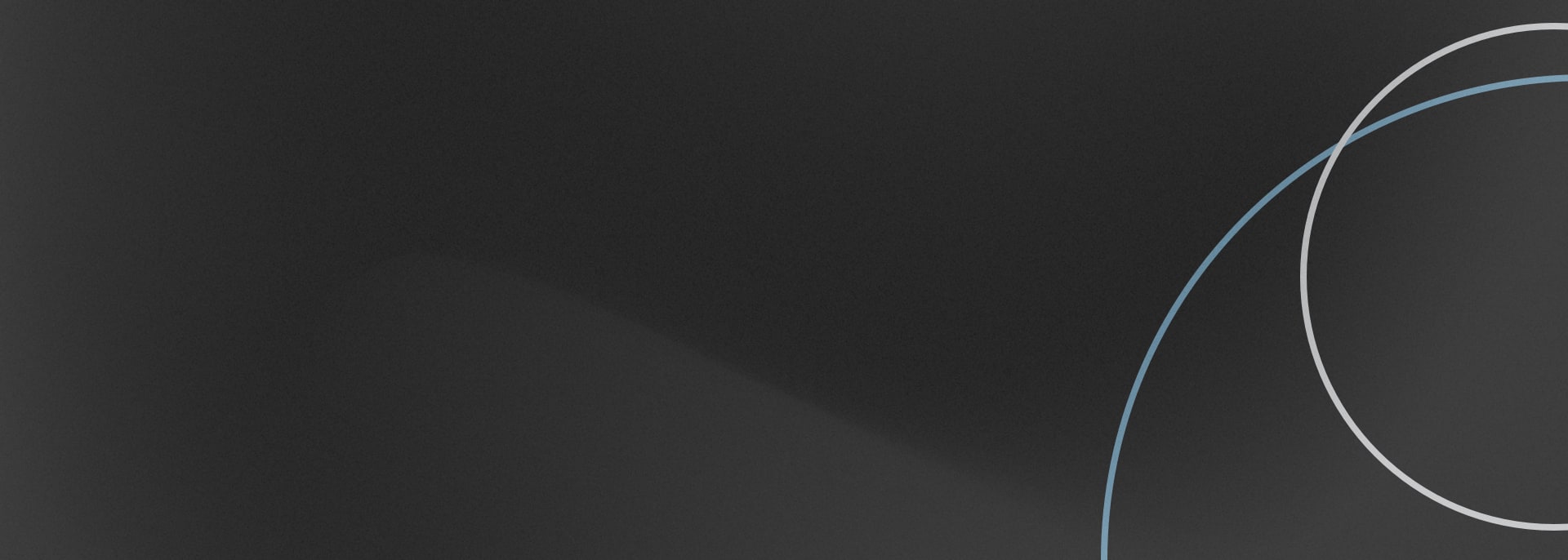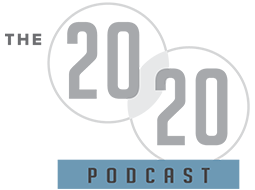
I attended the Myopia Luminaries event in October, which was hosted by CooperVision in New Orleans. The event took place just before the American Academy of Optometry meeting. It was a true gathering of leaders, both clinical and research-based, in myopia management from across North America. Just before the event started, I had the chance to sit down with Dr. Justin Kwan who is the Senior Manager of Myopia Management in CooperVision’s Professional and Academic Affairs group. In our conversation, Dr. Kwan explained how CooperVision is expanding the field of myopia management by offering products for patients and solutions for doctors.
Learn more at https://coopervision.com/myopia-management
—
Watch the episode here
Listen to the podcast here
Myopia Luminaries With CooperVision – Dr. Justin Kwan
I am truly excited right now. We are in New Orleans for this Myopia Luminary Forum hosted by CooperVision. I’m so grateful to CooperVision for having me here and to my wonderful guest, Dr. Justin Kwan for having me and for being here taking the time out to talk to us about myopia management and the importance of myopia management in optometry. Justin, thank you so much for being here.
It’s an honor to be your guest and I’m excited to dive in.
Thanks. I appreciate it. Justin, let’s talk about this. We’re in this beautiful venue at Antoine’s Restaurant here in the French Quarter in New Orleans. What are we doing here?
This has been a bit of a recurring event. It came into genesis when we realized there’s a whole bunch of doctors practicing myopia management, but there are also superstar clinicians and those that have influence, whether it’s in their association or what have you. We wanted to bring in a higher level of scientific but also relevant conversation so that they could sit around these tables and share ideas with each other. This is our third time doing it and great stuff has come out of it.
I was looking at the name tags of the people who were coming and I was like, “I know that person.” All those people here in one room, the energy is going to be crazy. We’re doing this before the event starts. We are taking advantage of the space, but I’m excited about that. Tell me about why from your perspective myopia management is so important. We’re hearing a lot about it. Why is it so important right now for ODs in general to be looking at myopia management?
Sometimes I feel like I live in this alternate reality to what’s happening in the trenches, and I miss patient care all the time. We’ll say stuff like, “The World Council of Optometry has made my myopia management standard of care almost two and half years ago..” All the pediatric ophthalmology associations have gotten behind that. They have their consensus statement, but I’ve read a book where between positivity and negativity, sometimes doctors receive standard-of-care messaging as a negative thing.
It’s a little bit harder to rally behind that. We tried different things and tried to move things forward as quickly as possible but being sensitive that doctors like yourself are busy. We need to lean into that and figure out what your current needs are now, and how we can help you in the weeks and months to come to get started with that standard of care without using those words.
I never thought about the word standard of care coming off as negative, but that does make sense. I’ve been fairly entrenched in myopia management for some years now. When somebody tells me that they think myopia management should be the standard of care, I say, “Of course, it should.” I’m the one sharing that message to a lot of people but I never thought about the other side of that. You might get a little defensive being like, “You’re calling it standard of care. Does that mean I’m practicing a little bit less now?
Am I any less of a doctor right now just because I haven’t had the time to get going?
We do want to encourage our colleagues to get more involved in this. Whether we call it standard of care or whether we say it’s something that we want to do to help our young patients, what pieces of advice do you feel have you been sharing that’s helped somebody who’s just dipping their toes and not doing it that well, but would like to get more into it.
I think like most things new, it can feel a little bit intimidating like, “I didn’t do a residency,” and it’s okay. Also, myopia management has sat in a special day space for so long. I think we’re trying to demystify that by that. Not that there aren’t complexities but that this is primary eye care. It should be simple. We can help make it simpler and then parents should know about the simplicity of helping their child’s eye health now and into the future.
We’ve shifted from the early adopters. We’ve taken the bull by the horns with a lot of ortho-k that have grown with my sight and now we’re saying that for the masses, we need every person and all hands on deck. It can be quite simple. It doesn’t have to be time-consuming. It doesn’t have to be something you wait and do. You can start today. That’s our primary message here.

I think that’s such an important message. Coming from my perspective in the clinic, I’m encouraging doctors to have the conversation. Even if you’re not doing myopia management, if you start to talk to parents about it, share the message, and let them know that these things exist, I think you’ll get a lot of positive feedback. You’ll see how quickly patients and parents are willing to adopt this new form of treatment and management of myopia. Most parents whose kids are nearsighted are also nearsighted so they understand. They’ve been through it. If somebody had given them an option 20 to 30 years ago, they would have jumped on it. Just having that conversation and getting the ball rolling in that sense can be super helpful.
A lot of parents are our age, but they grew up on daily disposables too. It’s a very familiar thing. I think there’s that urgency to it. You’re right that education is a form of treatment. In large part, we’ve noticed that not a lot of ODs are seeing kids kindergarten through third grade in general. We have to move in that direction to have any semblance of impact.
I’d like to try to speak to people who are doing something at a much higher level than me. I’m speaking to people within the myopia management space. We’re doing things at a much higher level and I’m asking them, “How many people or how many ODs out there do you think are doing myopia management actively?” They are not just making recommendations, but actively seeing patients. How many young myopic patients are there in the United States or North America? When we look at those numbers, it seems like we’re just at the tip of the iceberg scratching the surface on how many patients we’ve been able to help. There’s so much more opportunity there.
I put a lot of work behind that estimation because a lot of survey papers had updated their estimate for a decade. One of my Arvo posters from a couple of years ago was using the 2020 census and some trivia literature about urban versus rural rates of myopia. I came up with a new number. It’s about 19.5 million kids with myopia. It’s aged 5 to 17. Other estimates would say 15 million, but I think it’s a lot higher than that based on my previous work. That translates to bringing closer to home about 300 kids, as well as 300 kids per OMD and ophthalmologist as well. In reality, we probably have more than 900 to take care of each one of us.
If you’re going to be primary care providers, the ones that are seeing the OMD likely are coming through us at some point.
It’s more spread out. Pediatric ophthalmologists are only in about 10% of all the US counties. It is an optometrist that’s going to own, and we have much better coverage across counties.

The opportunity is massive there. I want to keep it more towards how we can do things in the clinic to help parents and the kids, but if we’re going to look at the bottom line, if we’re a business owner and have a business we want to run, the bottom line is boosted in benefit from adopting this specialty. We can get into that a little bit more, but what I wanted to go into is what Cooper is doing. I know there are a lot of different opportunities, services, products, and programs. We can share a little bit about what Cooper is doing to help ODs get into this space.
A great part of my job is I work closely with the Canada team as well because you all had the market sooner and then the program changed a little bit. We’ve both adopted along the way and learned a lot. Primarily, we use our myopia management specialists. We call them our myopia rep. There are 10 in the US and 4 in Canada. I think of them as a consultant. They can train your staff. They can help you arrive at a set of fees that make sense for your practice.
They can customize whether you have 500 square feet or 10,000 square feet and bring it to life again in the more simple fashion and to get more consistency. I have a question for you too. I’m trying to ask as many ODs. How do you get the children of adult patients in for eye exams? If we crack that, then we’ll have more flood of kids coming in.
I feel like that’s easy for a couple of reasons and some of these don’t translate across borders. The one that does translate is when you’re talking to a parent who’s nearsighted, for example. They’ve gone through this. They’ve lived it. They know what it’s like to have to rely on their glasses all the time. You tap into that a little bit.
There are two sentences that I feel like that work well for me. I call it the silver and the gold. The silver sentence is, “When we were younger, Justin, we didn’t have any of these options. We just had to wear glasses. You have to rely on that. It doesn’t matter if you’re running around, you’re playing, or whatever you’re doing, you have to wear your glasses. Now, we have options that can help our kids to slow the progression and they won’t be as dependent on their glasses. Perhaps, they’ll have more options available. That I feel resonates quickly.
The golden statement is when I have the patient in the chair and when the child is in the chair and I say, when we’re trying to decide on should we do myopia management? This is the true sentence that I say. The sentence is very simple. “If this was my child…” That seals the deal with the parent when they’re already there. “If this was my child, this is what I would do.” “My daughter does wear glasses. Here’s what I did.” If you don’t have kids, you can still use that sentence.
If you want to, a secondary might be, “If this was my niece or nephew,” or someone that you have in your family, you can use that statement, but I feel like that does well. For us in Canada, the other thing about bringing kids in is that we have in our province, the government does pay for child eye exams. That eliminates any reason that a parent might have. It’s covered. Just bring them in. We’ll take care of the rest. Just letting the parent know that we have options available that didn’t use to exist when we were younger usually does it right there and then. The fees are a whole different conversation.
Also, make sure your staff officially gets the children on the schedule.
The next is I go to the front and I’ll let the staff know as they’re checking out the parent that also this lady or this gentleman would like to book their son or daughter in for their eye exam. Can we do that? They’ll take care of it from there.
A couple of lines I’ll steal from our colleagues to close that conversation is, “We’re here to put your child on the best path forward.” As you said, we’re not selling anything just yet. We have eye health concerns. We have long-term success. Children use their eyes for learning, for performance, and all their activities as well. I think that brings it home.
We’re just here to put your child on the best path forward.
You also mentioned relating back to the standard of care, “Just doing our job.” Sometimes I say, “It’s our job to get your child’s eye growth back on track because right now, it’s too fast. It’s 2 to 3 times too fast. Their eye is getting too long and it’s getting weaker. It’s my job to take care of your child.” Parents don’t let any other medical condition get worse.
When we can start showing them some numbers and tracking those, I think it helps. Just as you would with any other health condition. You’re looking at your blood pressure. You’re looking at your numbers. Is it going up or is it going down? Your cholesterol, is it going up or going down? The progression of the axial length, is the progression increasing, slowing, or stabilizing?
Also, having those tools and sharing them. At the same time, I want to speak to my colleagues out there. Don’t get overwhelmed or don’t dwell on the fact that you don’t have axial length or anything like that right now. You don’t need that to get started. In my opinion, you just need to start having the conversation. All the other stuff comes after.
It took about twelve years for 80% of our profession to buy all the CTs. I think it’ll be a little bit faster just because axial length is a fourth of the cost.
You can recoup it faster too. Cooper’s primary flagship product in the myopia management space is the MiSight lens. How can we encourage our colleagues to get more comfortable using that lens and recommending that lens?
If you look across your patient population, you have a lot of kids wearing single-vision contact lenses not for myopia control, but for vision correction, and again, whether they’re an athlete or they’re in the performing arts, there are so many benefits. In some ways, single vision is the wrong lens. It’s a device that lets their disease get worse.
In some ways, single vision is the wrong lens. It’s a device that lets their disease get worse.
You can start there with that patient population and then move younger as you get more comfortable. That’s the beauty of a daily disposable. You don’t have to order it and wait for it. It’s right there in the office. You can have stuff. My mentor at CCO where I taught said, “Get a lens on the eye.” I think that’s a child’s smile and the parents reacting to their child’s smile sells itself sometimes.
A lot of what you said Justin, I never thought of it this way, but I see a lot of parallels with fitting multifocal on the opposite end of the age spectrum here. If I were to put a 60-year-old on a single vision, we know they’re going to struggle with that. What I do with a lot of those patients is get a lens on the eye. I say to the patient, “Let me put a multifocal on for you, and then let’s see what you think.” Why are we not doing that with young patients? It’s so interesting that I never thought of it that way.
Similarly, that presbyopic patient is not going to care about the studies or the numbers of success. They want to know, “Will it work for me?” and the only way is to put the lens on.
I think we’ve covered more topics than what I was expecting. Are there any final words or important key messages you want to share with our colleagues out there who are just starting to get into it or maybe thinking about getting into myopia management?
I’m a huge proponent of goal-setting. You don’t have to have super lofty goals. Again, setting a one-week, a one-month, and a quarterly goal in anything, but start somewhere. What I mean by that is there’s an acronym called SMART. Be very Specific, Measurable, Actionable, Relevant, and Timely. If you think about it, “I’m seeing about eighteen patients a day. Are three of them children? If not, how do I get there?” Just start somewhere. It doesn’t have to be this whole myopia thing first. You can then build the bridge as you cross it.

I see a lot of kids in my practice. In general, from day one we built the practice to be that of a family practice but as you mentioned, a lot of ODs don’t have that. They specifically don’t see younger kids. I always find it surprising when I speak to a friend of mine wherever they might be based or see kids. Let’s say you’re thinking my open management might be the right thing for your practice as a new specialty you want to bring in, start talking to the parents. Start talking to your patients who are parents and recommend that they bring their kids in to see you. Start to build that side of your practice like that. First is to get them in and then start talking to them.
You then have CooperVision support you with the training, the staff, and all that good stuff.
Before wrapping up, I want to dig a tiny bit deeper into your myopia specialist that you have all over North America, Canada, and the US. I like having that person that you can call and say, “What should I do next?” This is new and I find a lot of parallels to when I was going into dry eye. We had one company that had that support for us. That person would come into our office and say, “You need to set a protocol. You need to set some framework.” Setting fees is such an important part of the introduction because people are like, “How much do I charge for this?” It’s cool that you have that. When somebody’s going into it, how accessible is that myopia specialist? How do you get in touch with it?
Each one is focused primarily on about 120 practices or so. They are tasked with responding quickly via text message, email, or phone. They are available at all times. They have a rich background themselves. They were hired because they spent time in practice either as an office manager, a contact lens coordinator, or a vision therapy program director. They know what it’s like working with kids. They were hired because they have skills and experience in that arena so they can speak staff to staff. That goes a long way.
That is hugely invaluable to have somebody who knows how the office works. It’s not just somebody who’s been trained or was yelling baby formula. They’ve been in there. They have the expertise. That’s massively valuable. Justin, thank you so much. I appreciate this conversation. I want to say thank you to you. I want to say thank you to Cooper for having me here at the Myopia Luminary Forum, and also for providing the services and support that you do to the profession and the industry. Thank you very much for that.
It’s invaluable to have somebody who knows how the office actually works.
Everybody who’s tuning in to this, thank you very much for tuning in. Make sure that you check out Cooper and all the services and programs that they have available to us to help us get into this very important specialty to serve our young patients and help them perform at their best. Thank you again, guys. I will see you in the next episode.




